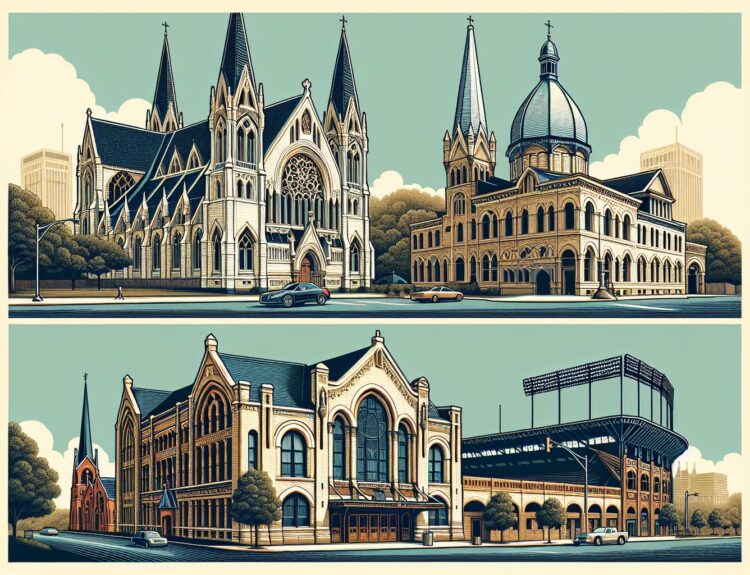Exploring Detroit’s architectural landmarks on foot is a journey through history, culture, and innovation. As I lace up my walking shoes, I’m filled with excitement to uncover the hidden gems scattered throughout the city. From the iconic Fisher Building to the historic Guardian Building, each structure tells a unique story of Detroit’s past and present.
Walking through the streets of Detroit, I’m immersed in a blend of Art Deco, Gothic Revival, and modern architectural styles. The vibrant cityscape is a testament to Detroit’s resilience and creativity, with each building offering a glimpse into the city’s rich architectural heritage. Join me on this self-guided tour as we wander through the streets, discovering the beauty and charm of Detroit’s architectural wonders.
Detroit’s Architectural Landmarks: A Historical Overview
Detroit’s architectural landmarks are a testament to the city’s rich history and vibrant culture. Detroit, often referred to as the “Motor City,” is not only famous for its automotive industry but also for its stunning architecture that tells the story of its past.
- Detroit’s architectural scene is a blend of Art Deco, Gothic Revival, and modern styles.
- The city’s architectural landmarks have stood the test of time, showcasing both resilience and innovation.
Walking through the streets of Detroit, you can’t help but marvel at the iconic buildings that have become symbols of the city’s progress. From the Fisher Building with its intricate mosaics to the Guardian Building with its stunning Aztec-inspired design, each landmark has a story to tell.
Detroit has been through highs and lows, but its architectural wonders remain a source of pride for its residents and a draw for visitors looking to uncover the city’s hidden gems. As I embark on this self-guided tour, I am excited to delve deeper into the history and beauty of Detroit’s architectural landmarks.
Planning Your Self-Guided Walking Tour
When planning your self-guided walking tour of Detroit’s architectural landmarks, consider a few key factors:
- Research: Gather information about the architectural wonders you wish to explore.
- Map: Get a detailed map of Detroit highlighting the locations of significant buildings.
- Comfortable Shoes: Wear comfortable shoes as you’ll be walking quite a bit.
Start your day early to take advantage of the natural light for photography. Don’t forget to pack water and some snacks for the journey. Enjoy the freedom of exploring at your own pace and immerse yourself in the beauty of Detroit’s architectural heritage.
The Iconic Fisher Building: A Jewel of Detroit
When embarking on a self-guided walking tour of Detroit’s architectural marvels, one simply cannot miss the Fisher Building. This historic skyscraper, located in the New Center area, stands as a true gem of the city’s skyline. As I gazed up at its intricate Art Deco details and grandiose structure, I couldn’t help but be awestruck by its sheer beauty and significance.
Designed by renowned architect Albert Kahn and completed in 1928, the Fisher Building boasts a unique blend of opulence and innovation. Standing at 30 stories tall, it exudes an air of elegance that transports visitors back to Detroit’s golden age of industry and prosperity.
Not only is the Fisher Building visually stunning, but it also houses a theater that showcases a variety of performances throughout the year. This cultural hub adds another layer of richness to the building’s already impressive legacy. As I wandered around the lobby, adorned with marble, bronze, and mosaics, I felt a sense of reverence for the history and artistry that permeate the space.
Stepping outside, the Fisher Building’s exterior features intricate sculptures and ornate details that tell a story of Detroit’s rich past. Whether admiring it from afar or up close, one can’t help but appreciate the craftsmanship and dedication that went into creating this architectural masterpiece.
Discovering the Historic Guardian Building
One of the architectural gems on my self-guided walking tour of Detroit is the Guardian Building. Built in 1929, this National Historic Landmark is a prime example of Art Deco architecture in the city. As I approached the building, the striking exterior with its colorful terracotta tiles and intricate designs immediately caught my attention.
Stepping inside, I was awestruck by the awe-inspiring interior featuring a stunning lobby adorned with Pewabic pottery, Rookwood tile, and a ceiling that soared above me. The mix of geometric patterns, vibrant colors, and exquisite craftsmanship truly showcased the building’s historical significance.
Exploring further, I learned that the Guardian Building was once home to the Union Trust Company, a financial institution that played a vital role in Detroit’s economic development. Today, the building houses offices and serves as a testament to the city’s past prosperity.
During my visit, I also discovered that the Guardian Building offers guided tours for those interested in delving deeper into its history and architectural splendor. These tours provide a fascinating glimpse into the building’s unique design elements and the stories behind its construction.
As I continued my journey through Detroit’s architectural landmarks, the Guardian Building left a lasting impression on me, highlighting the city’s rich history and artistic legacy.
Exploring Modern Architectural Marvels
As I continue my self-guided walking tour of Detroit’s architectural landmarks, I can’t help but marvel at the city’s blend of old and new. Detroit’s modern architectural wonders stand out amidst its historic buildings, showcasing innovative designs and futuristic concepts. Here are a few must-see stops that highlight the city’s contemporary architectural achievements:
- One Campus Martius: This striking glass skyscraper, also known as the Compuware Building, dominates Detroit’s skyline with its sleek and modern design. The building’s reflective facade shimmers in the sunlight and houses various retail spaces, restaurants, and offices, making it a vibrant hub in the heart of the city.
- Detroit Institute of Arts: While renowned for its extensive art collection, the Detroit Institute of Arts is also a masterpiece of modern architecture. The museum’s sleek exterior contrasts with the historic buildings surrounding it, drawing visitors in to explore its impressive galleries and exhibitions.
- The Qube: Formerly known as the Chase Tower, this iconic skyscraper captivates with its unique geometric design and distinctive blue glass exterior. The Qube’s innovative architecture makes it a standout feature in Detroit’s downtown district, symbolizing the city’s embrace of modernity.
- Little Caesars Arena: Home to the Detroit Red Wings and Pistons, this state-of-the-art sports and entertainment venue blends seamlessly into the cityscape with its modern facade and dynamic architectural features. The arena’s innovative design and sustainability initiatives set a new standard for urban architecture in Detroit.
These modern architectural marvels not only enrich Detroit’s skyline but also symbolize the city’s evolution and embrace of contemporary design principles. As I explore these innovative buildings, I am inspired by Detroit’s ability to seamlessly blend its rich history with cutting-edge architecture, creating a unique and dynamic urban landscape for visitors and residents alike.
Conclusion
Exploring Detroit’s architectural landmarks on a self-guided walking tour has been a captivating journey through the city’s modern marvels. Each building, from the sleek One Campus Martius to the iconic Qube, showcases a unique blend of innovation and history. Detroit’s commitment to cutting-edge design principles is evident in every structure, enriching the city’s skyline and inviting visitors to immerse themselves in its dynamic urban landscape. As I’ve wandered through these architectural wonders, I’ve been inspired by the fusion of old and new, witnessing Detroit’s evolution firsthand. The self-guided tour not only offers a glimpse into the city’s architectural heritage but also serves as a testament to Detroit’s vibrant spirit and enduring legacy in the world of modern architecture.






